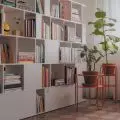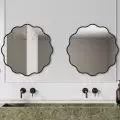Work submitted for the competition
"Best Interior Design Diploma".
Living in an era of hyper-consumerism, the notion of a designer's responsibility to the environment is becoming important. The construction sector is responsible for 37% of global greenhouse gas emissions, causing environmental degradation that threatens the survival of humanity. Carl Elefante, former president of The American Institute of Architects, said: "The greenest building is the one that wasn't built." Next in line is an existing building that can be given new life. The theme of the project is to transform an abandoned building into an educational space with natural construction. The concept is based on sustainable construction.
axonometry
© Monika Zywiecka
A historic granary from the second half of the 19th century, owned by Podlaskie Konopie, a company specializing in seed hemp farming, is an example of this approach. In the past, the granary served various functions: storage of sausage products in the attic, dormitory during the summer, and each floor had a separate function. Each of these functions was important from both a practical and symbolic point of view, making the granary the centerpiece of the farm.
visualization
© Monika Zywiecka
The project envisions transforming the first floor into a main educational space with a courtyard and an exhibition hall. The first floor will house sanitary facilities, a kitchen, a dining room and a reading room, while the attic will be transformed into a sleeping area with traditional elements, such as walls woven from hemp ropes. The sleeping space will be divided into 10 double rooms and two single rooms, adapted for people with disabilities. Each room will be cordoned off with hemp fiber curtains, creating a mix-used space, allowing for 24-hour use and reducing traffic.
visuals
© Monika Zywiecka
The building will be fully handicapped-accessible, with wide doors and walkways and an elevator. Kitchen countertops with a height of 85 cm will be extended to allow wheelchair access. In line with the idea of barrier-free design, the reception and sanitary space will also be adapted. The space has been designed with comfort and functionality for all users in mind, which is key in a modern approach to architecture.
visualization
© Monika Zywiecka
A key element of the project is to minimize greenhouse gas emissions by renovating the existing building. To illuminate the interior without interfering with masonry structures, an interior courtyard was planned with numerous windows between the rafters. A central light will distribute natural light throughout the interior. The layout of the partitions will provide air flow, minimizing the need for air conditioning. A metal light installation will provide illumination after dark.
visualization
© Monika Zywiecka
The west gable wall will be altered to meet fire safety requirements through an escape cage made of recycled materials from neighboring demolitions. This fits in with the Urban mining ideology, which reduces waste and carbon footprint. Urban mining is the processes of extracting raw materials and resources from materials from urban areas to reduce waste and reuse available materials.
visualization
© Monika Zywiecka
The project uses natural materials in accordance with the principles of sustainable construction. Partition walls made of konoplite, a material made from hemp seed, provide microclimate and sound insulation. Hemplite is an extremely environmentally friendly material that produces more oxygen than comparable areas of forest when grown. The walls are covered with clay plaster, which further improves the interior microclimate and acts as a sound insulator. The design process takes into account the value of the site's history and the idea of sustainable construction, showing that it is possible to combine modern solutions with respect for tradition.
visualization
© Monika Zywiecka
{tag:studenci}
Illustrations: © Author














































